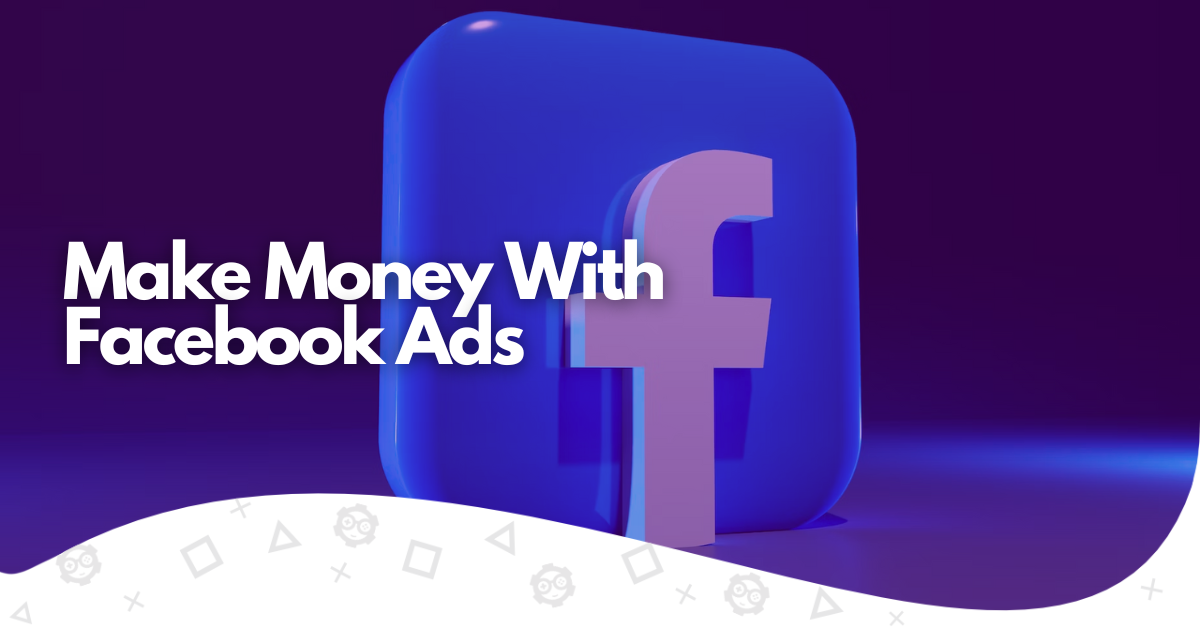In the digital age, Facebook is a powerful platform for advertisers, one of the top online choices for businesses worldwide.
Whether you’re a service-based company trying to engage potential customers or an eCommerce platform seeking direct online sales, mastering Facebook advertising can significantly boost your revenue.
This article explores the best ways to make money with Facebook ads, exploring strategies from setting clear campaign goals and choosing the right audience to optimize ad types and landing pages.
So, if you want to know how A/B testing, compelling ad copy, and video ads help you sell your products and earn money, you are in the right place. We’re here to equip you with actionable tips to enhance your advertising efforts and achieve your business objectives.
- Determine Your Campaign Goals
- Choose Your Target Audience
- Establish Your Facebook Sales Funnel
- Divide Your Ad Campaigns by Countries/Regions
- Monitor the Correct Website and Ad Metrics
- Choose the Right Bid Strategy to Manage Your Costs
- Create Your Ad With The Facebook Catalog
- Create Ads With a Direct Call-to-Action
- Use Video Ads in Your Campaigns
- Run A/B Tests
- Enhance Your Landing Page
- 3 More Tips to Make Money With Ad Campaigns
- How to Make Money With Facebook Ads – Conclusion
Determine Your Campaign Goals
Being aware of your goals is vital for a successful Facebook advertising strategy and the first thing you must consider if you want to make money running Facebook ads.
What are you looking to gain from the Facebook Ads? Engagement, conversions, or brand recognition?
The goals you set should mirror the outcomes you desire. Here are six Facebook Ad Manager objectives you could target:
- Awareness.
- Traffic.
- Engagement.
- Leads.
- App promotion.
- Sales.
To recognize your campaign objective, consider your industry and business model. Service-based businesses might prioritize lead generation, while e-commerce businesses may aim for direct online sales.
Before diving into the Facebook Ads Manager, it’s imperative to outline what you want to achieve. Whether you seek to enhance brand awareness, store visits, or boost online sales, your goals will shape the trajectory of your Facebook campaign.
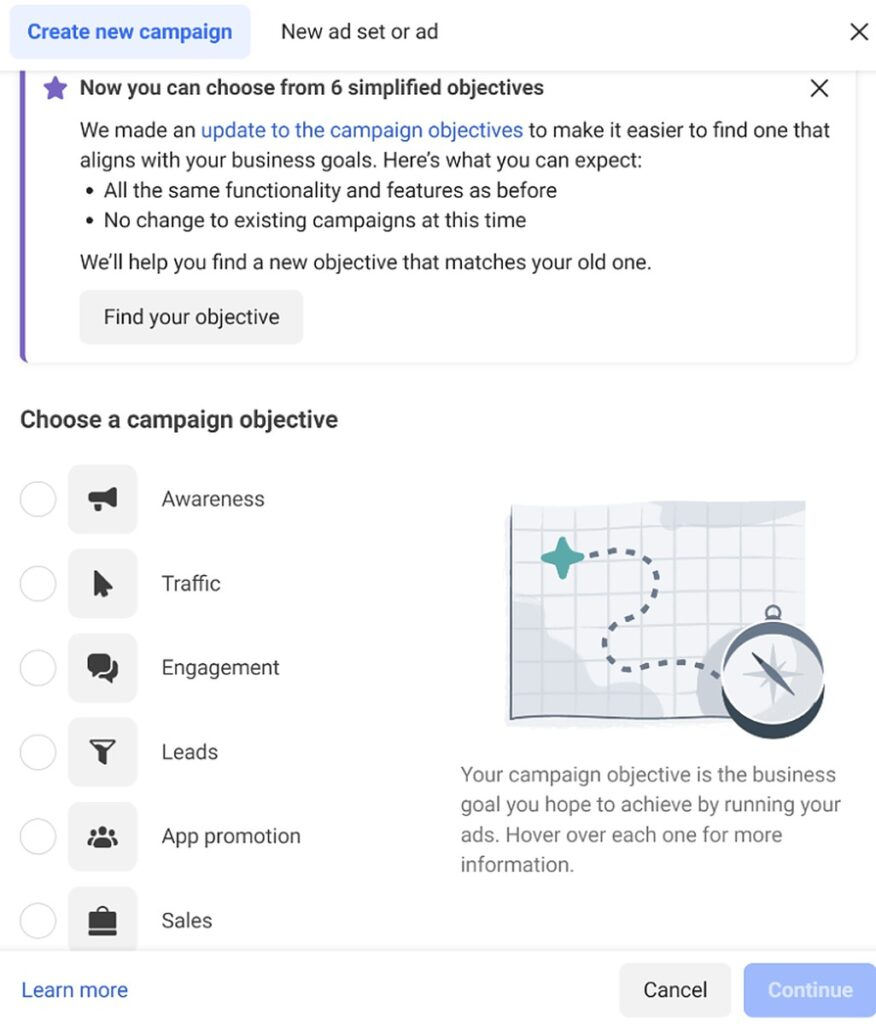
Choose Your Target Audience
Choosing the right audience is the second stage in your Facebook ad campaign. Define your target, considering gender, age, interests, location, and behaviors.
Facebook Ad Management offers multiple targeting options, allowing you to filter your audience based on demographics, buying habits, and self-marked interests.
There are two types of audiences:
Custom Audiences
Facebook’s custom audience option lets you target specific individuals in your advertising campaigns.
Here are four types of custom audiences and how they work:
- Website Visitors: You can generate audiences based on the visitors to your website. This custom audience type allows you to segment Facebook users, whether they explored your entire site, particular product pages, category pages, or even the shopping cart.
You can segment further by selecting a timeframe to target recent visitors or re-engage those who last visited a while ago.
- App Visitors: Similar to website visitors but related to those who have interacted with mobile apps.
- Customer List: You can set a list of your previous customers to create a distinct audience for your Facebook ad campaigns. This option will match the provided e-mail addresses to users on Facebook’s platform, allowing you to run targeted campaigns to re-engage past customers.
- Engagement: This option focuses on customers who have actively engaged with your business page on Instagram or Facebook through likes, comments, shares, and additional interactions.
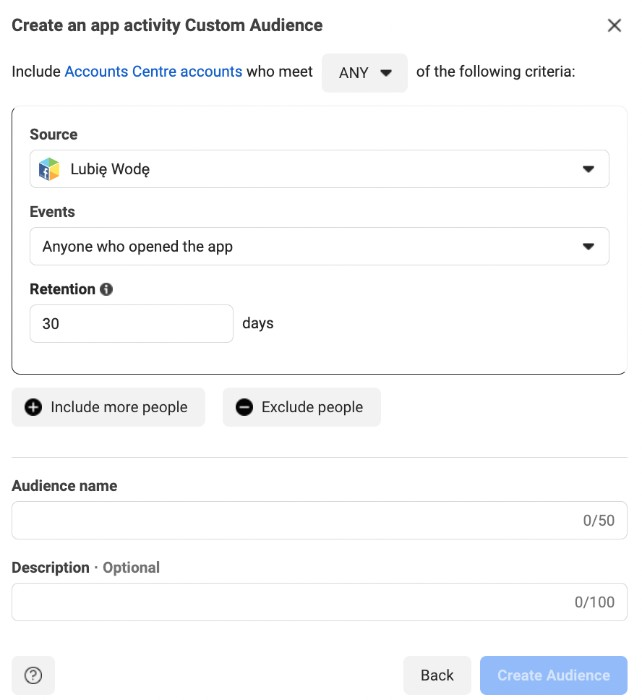
Lookalike Audience
Lookalike audiences enable you to target new potential customers who share characteristics with your existing clients. You must generate “source audiences” using the exact data from custom audiences.
These sources typically include:
- Website visitors.
- App visitors.
- Customer Information lists.
- Engagement on Instagram and Facebook.
- Phone calls and in-person interactions.

Establish Your Facebook Sales Funnel
Like any other marketing channel, Facebook ads require a strategic approach, and this is where the marketing funnel’s concept comes into play.
The marketing funnel’s foundation is placed on the idea that customers travel through several stages before they’re ready to purchase. These phases help businesses segment their audience based on their current interest level.
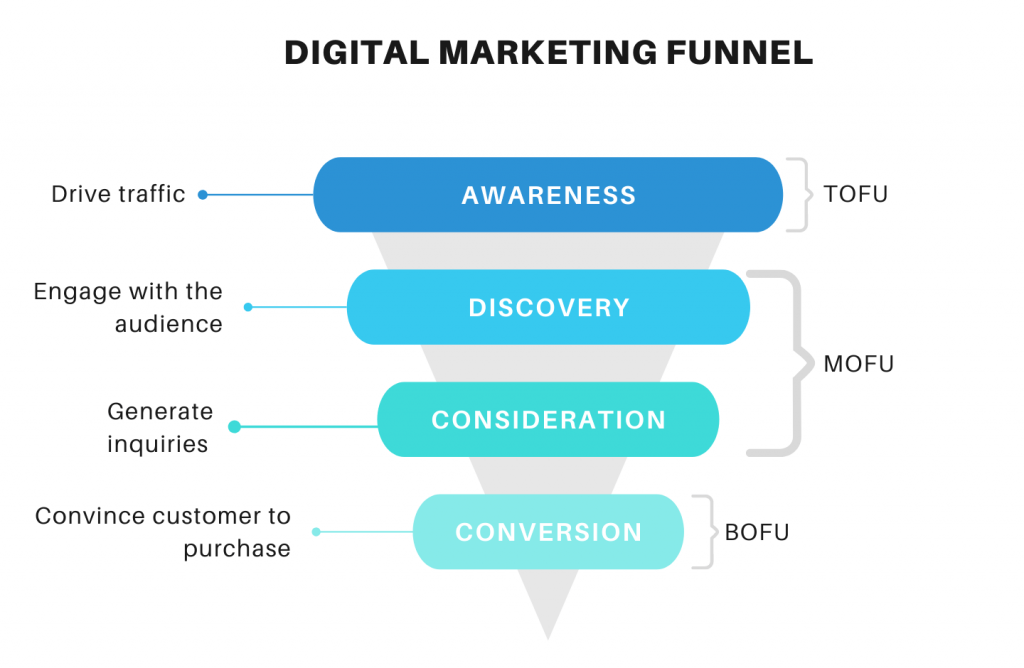
Traditionally, the Marketing funnel stages include:
- Awareness: introducing potential customers to your brand or product.
- Discovery: providing more information about your products.
- Consideration: engaging potential customers as they evaluate their options.
- Conversion: encouraging the final purchase decision.
However, we recommend a better condensed and actionable version of this funnel. This is because your FB ads’ success is based on the balance between ad spend and the revenue it generates.
For instance, increasing awareness is valuable but doesn’t directly translate to sales. So, we suggest a new three-stage funnel for your Facebook page and ads.
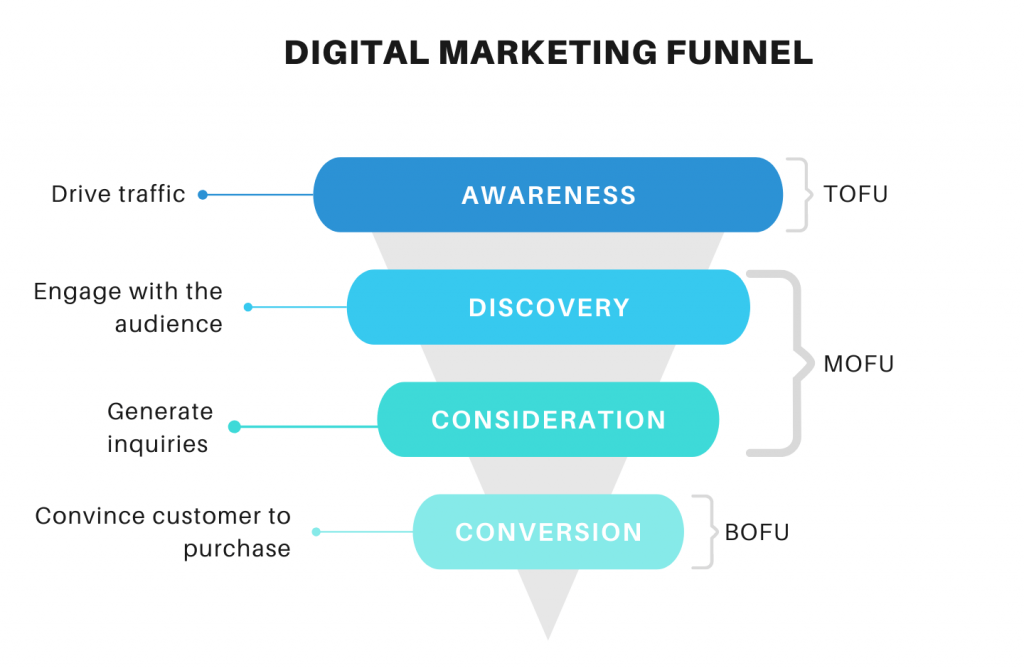
Acquisition
The objective at this stage is to introduce your brand to new audiences and warm them up for the following steps.
The strategy involves beginning with custom and lookalike audiences to drive more traffic to your Facebook page.
As you gain experience running ads, your acquisition campaigns will better guide high-quality leads through your funnel.
Retargeting
It aims to engage with individuals who have interacted with your brand but haven’t purchased yet.
Here, you must use the Facebook pixel to post ads targeting those who viewed your previous ads but didn’t interact with them.
Also, retarget the users engaged with your Facebook page, clicked on an ad leading to your websites, or explored your Facebook shop catalog.
Retention
This is the final stage to make money through Facebook ads correctly. The idea is to increase engagement and keep your existing customers by introducing relevant content.
The strategy uses customer data to run new campaigns promoting targeted cross-sell and upsell products.
Dynamic ads can automate this process, ensuring the same ad isn’t repeatedly shown to the customer.
Divide Your Ad Campaigns by Countries/Regions
Facebook Ads Manager offers several options for geographic segmentation, allowing you to target people in specific global regions, countries, states, and even zip codes. Additionally, you can set filters to include different city sizes.
Avoid grouping multiple countries or regions into the same campaign to increase your campaign’s performance. Instead, split your advertising campaigns into different areas and countries. This strategy can significantly boost your Facebook ads.
Why is this segmentation crucial? Other regions may respond differently to your ads and copy. What resonates with one audience might not resonate with another.
You can gain flexibility when you divide your ad campaigns. You can even incorporate the region or city’s name into the ad to create a better connection with your target audience.
One of our current clients asked us for a consultation as his company was struggling with their ads. The company was getting traffic from unwanted regions and didn’t know what to do. After checking the ad group segmentation settings, we realized they were targeting the whole world instead of just the US (which was their target.)
After making proper adjustments, their CPC lowered and increased overall budget performance.

Monitor the Correct Website and Ad Metrics
Monitoring on-site and advertising metrics is essential for earning money from Facebook ads.
Constantly checking these metrics will help you to understand user behavior, know the effectiveness of your campaigns, and make necessary adjustments for better performance.
On-site Metrics
This provides insights into user behavior and interactions on your website, resulting directly from your Facebook Ad Campaigns.
These metrics show your customer’s journey, from adding products to the cart to completing purchases.
Here is a list of the metrics to which you should pay specific attention:
- Form Submissions: Monitor the number of users completing forms such as e-mail opt-ins. Only some visitors will convert, but collecting e-mails allows direct marketing opportunities to encourage return visits and purchases.
- Add to Carts: You can measure the number of visitors who added a product to their shopping cart after clicking on your Facebook Ad. Comparing this with the total purchases will reveal your abandoned cart rate.
- Purchases: Track the total purchases directly to your Facebook Ad campaigns. This is a clear indicator of your ad efforts’ effectiveness.
- Checkouts Initiated: This metric indicates the number of visitors who started but didn’t complete the checkout process. Comparing this against total purchases gives you insight into the abandonment rate.
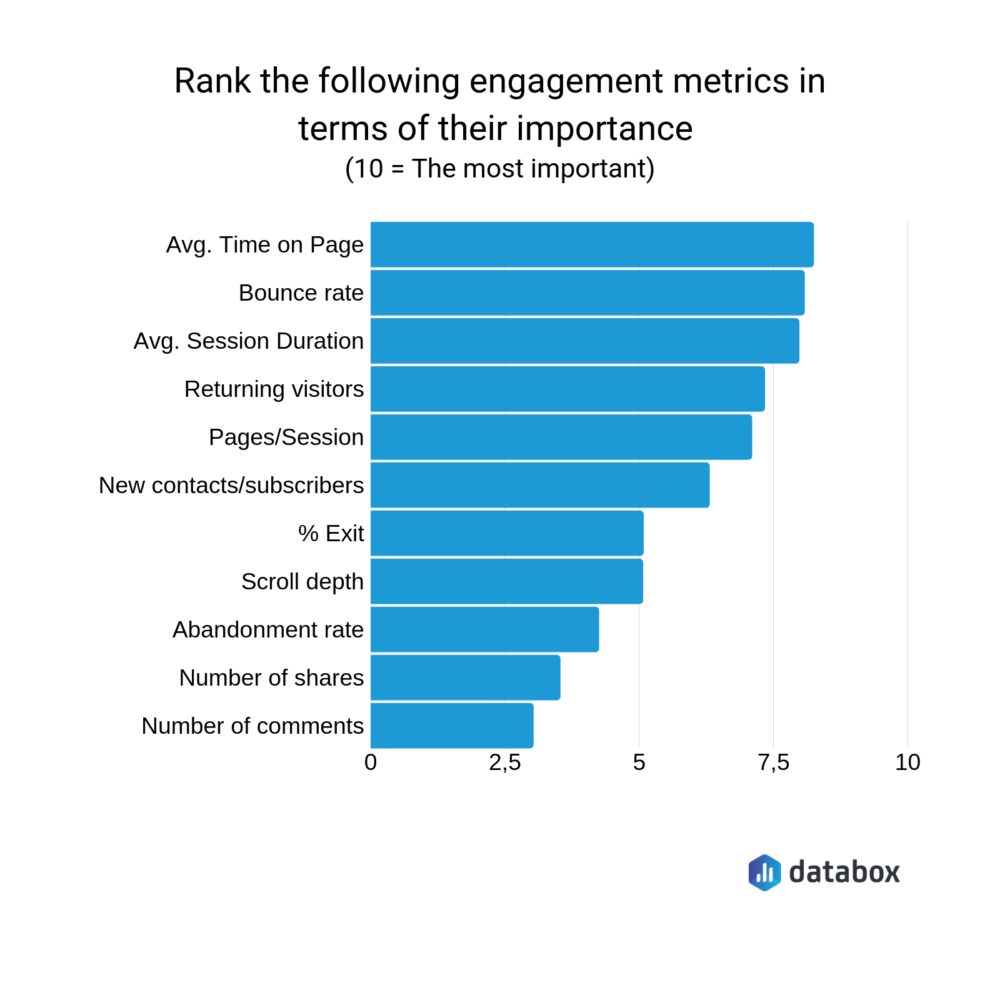
Advertising Metrics
Ad metrics focus on evaluating your Facebook ad campaigns’ effectiveness and productivity.
For instance, you can evaluate the reach and engagement of your ads to optimize your strategies, manage your budget effectively, and maximize your return on investment.
You can see advertising as a game of numbers that establishes target metrics that could give positive results.
Let’s see the metrics you should monitor:
- Click-Through Rate: CTR reveals the percentage of viewers who clicked on your ad and redirected them to your landing page. It reflects your ads’ appeal and relevance and helps inform if your campaign reaches the correct audience.
- Impressions: You can see how often your ad is viewed, indicating your ad’s success in capturing audience attention. This metric is influenced by budget, bid, and targeting.
- Reach: This shows you the number of Facebook users who have seen your ads, differing from impressions, which count multiple views by the same user.
- Amount Spent: Monitoring your ad spend on a campaign is crucial for effective budget management and calculating ROI by comparing expenditures against clicks, purchases, and revenue.
- Link Clicks: This metric counts the total number of clicks on your ads, providing a snapshot of user engagement.
- Cost Per Link Click: CPC calculates the average amount paid for each click, helping you manage costs.
- Cost Per Result: Evaluate the average cost to achieve a campaign objective, indicating the ad’s efficiency in driving results.
- Cost Per Add-to-Cart: Understand the average ad spend required to have a user add an item to their cart.
- Cost Per Purchase: Determine the average amount spent on ads to generate a purchase, providing insight into your effective campaigns.
- Purchases Conversion Value: Measure the total value of purchases from your ad campaigns to know overall profitability.
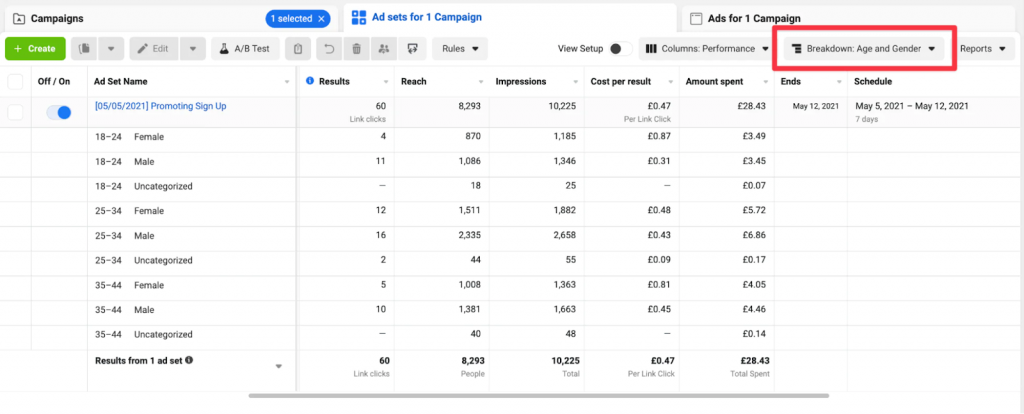
Choose the Right Bid Strategy to Manage Your Costs
You’ll come across different bid options when you use Facebook Ad Manager. They offer unique benefits depending on your campaign goal.
If you use Facebook’s Campaign Budget Optimization (CBO), when you create an advertisement, you can select one of the three bid strategies: Highest volume, Cost per result goal, and Bid cap.
But what’s the difference between these three options?
- Highest Volume: It gets maximum results for your budget without additional controls at the ad set level.
- Cost Per Result Goal: It helps you control the cost of your results and gets you the highest volume of results for your budget.
- Bid Cap: You can manually limit how much Facebook bids in auctions.
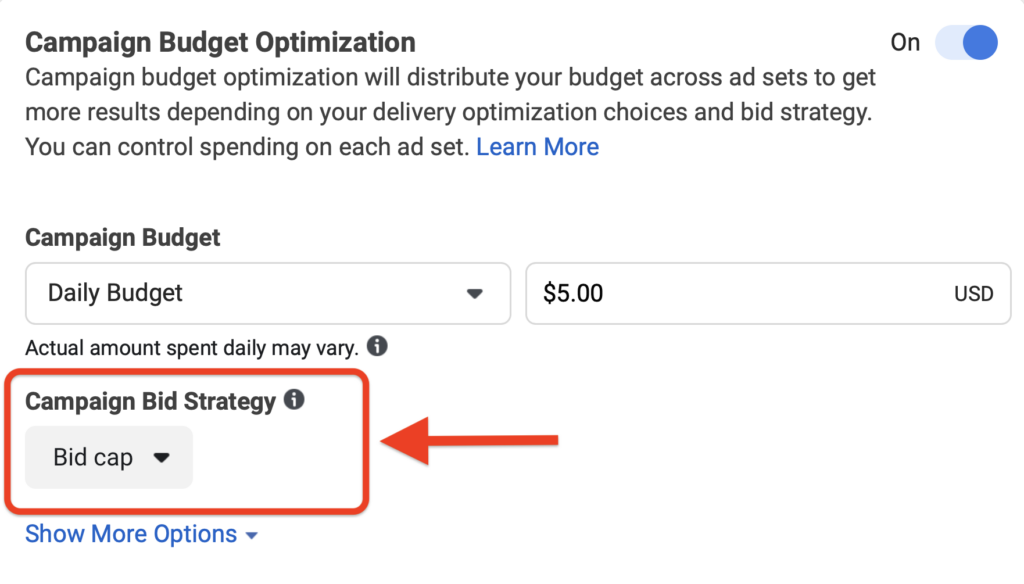
Define Your Ad Budget
Before choosing a bid option, let’s understand how to set your budget. Facebook offers two primary budgeting options:
- Daily Budget: It’s ideal for advertisers seeking continuous ad runs throughout the day, and the minimum amount for an ad set is $1.00 and must be at least 2x your Cost per link click.
- Lifetime Budget: Suitable for advertisers aiming to run ads for a specific duration.
Utilize the “Cost Per Result Goal” Strategy
Between the three Bid strategies mentioned above, we recommend selecting the option “Cost per result goal” to earn money with Facebook ads because it’s an effective strategy that aids in optimizing ad spend.
This option allows you to set an average cost for the event you are optimizing, such as add-to-cart, a sale, or any other measurable action. It’s an advantageous strategy for your online business because you must maximize your results while maintaining a specific cost per action (CPA).
For example, an eCommerce business aiming to get as many customers as possible without exceeding $50 per customer acquisition can set the purchase optimization event and the average cost per optimization at $50.
Initially, expenses may exceed the cap while Facebook’s algorithm learns to optimize your bids. We recommend you use the budget entirely during this phase for better learning and optimization based on your goals.
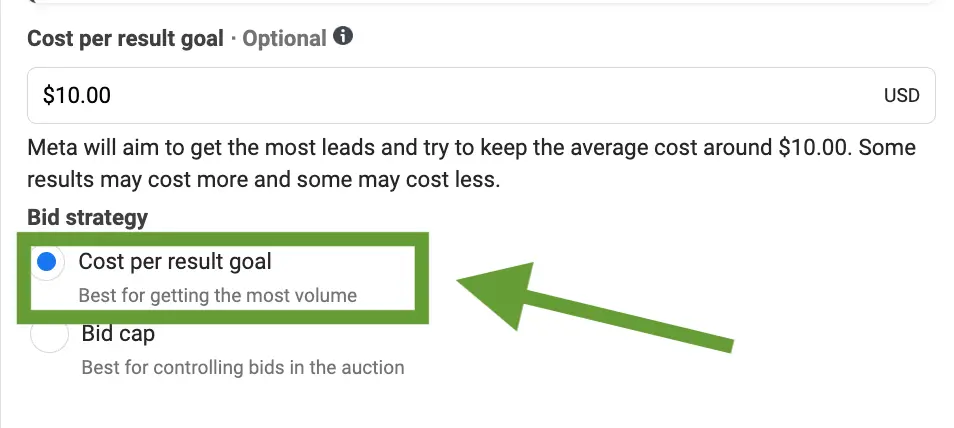
Create Your Ad With The Facebook Catalog
Creating the correct type of ads is crucial for your Facebook ad campaign’s success, especially if you are showcasing products. Utilizing a Facebook Catalog can enhance your advertising efforts, allowing you to display multiple products in a structured and appealing way.
Here’s a closer look at different ad types you can create using a Facebook Catalog.
Carousel Ads
They allow you to show up to ten images or videos within a single ad, each with its link. This format is ideal for highlighting different products or features and driving traffic to specific landing pages or your Facebook page.
Carousel ad also offers a more interactive shopping experience.
Collection Ads
You can use collection ads when you want to tell a compelling story about your products. This method provides users with a visual and immersive experience, combining videos and slideshows with product images from your catalog.
So, you can enhance viewers’ experiences with visually rich storytelling and facilitate seamless product exploration by leading them to a full-screen shopping journey.

Dynamic Product Ads
They automatically show different products or content to different audiences based on their interests and behaviors, using the information from your online store. This method is similar to other platforms’ dynamic ads, like Google.
It’s perfect for retargeting campaigns and reaching users who have shown interest in your product catalog or similar items. You can also increase conversion rates and reduce the time spent creating ads for your landing or Facebook business pages.
Collaborative Ads
These Facebook ads are ideal for brands and retailers looking to collaborate on ad efforts and maximize product visibility. It allows brands to partner with retailers to enable their product tracking and optimization on Facebook.
Retailers share their product catalog, and the brand can run Facebook ads with it. Then, you can expand the reach, optimize advertising efforts, and have accurate tracking and reporting.
Create Ads With a Direct Call-to-Action
Incorporating a direct call-to-action (CTA) in your Facebook ads is vital in crafting compelling ads and initiating a successful new campaign. A well-defined CTA guides your audience in what steps to take next and plays a crucial role in making money through paid ads on Facebook.
By explicitly stating what you want the audience to do, you significantly increase the chances of converting viewers into leads and, eventually, into more clients.
When you start creating your Facebook ads, pay special attention to the ad copy, ensuring that the call-to-action is clear, concise, and compelling. A direct CTA is like a beacon, guiding potential customers through the fog of countless ads on Facebook, leading them to your offerings.
A well-placed CTA can be the gateway to your objectives, whether your goal is to generate leads, increase sales, or drive traffic.
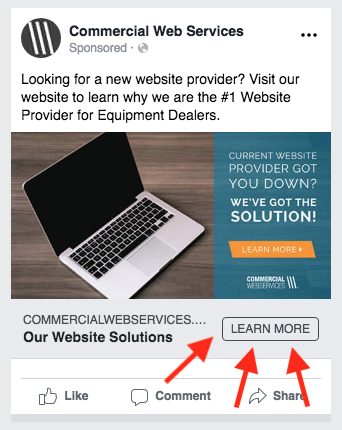
Use Video Ads in Your Campaigns
Incorporating video ads into your campaigns is a strategic move to capture the audience’s attention and drive engagement.
Video ads offer a visually compelling medium to show relevant content, tell your brand’s story, and help you make more money by converting viewers into new customers.
You can promote the videos in different ways, including:
- Stories
- Collection
- Carousel
- Messenger
- Slideshow
- Premium video
- Instant experiences
As you start selling your products through video ads, it’s essential to understand the best practices to optimize your ad sets and make the most of this powerful marketing tool. Here’s what we recommend:
- Prioritize Mobile Devices: You can’t imagine how many people use Facebook on their phones, so it’s essential to ensure your video ads look properly for devices’ dimensions, like creating a vertical video. This way, you have a better chance of getting users interested and helping them learn more about your business.
- Keep Videos Short: Viewers’ attention can be fleeting, especially on Instagram or Facebook. To keep users engaged, we recommend using 10-second videos in your ads. Short and interesting videos are more likely to be watched completely, which means people will see your message effectively.
- Visuals Over Sound: While sound can enhance the message, images and visuals are more important on Facebook. Users often scroll through their feeds with the sound off, so your video ads need to communicate the message effectively, even without sound.
- Make Your Thumbnail Images Stand Out: The first image people see in your video ad is important. It can make a big difference in whether users decide to watch your ad or not. You can encourage your customers to explore your business by optimizing your thumbnail images with appealing visuals and relevant content.
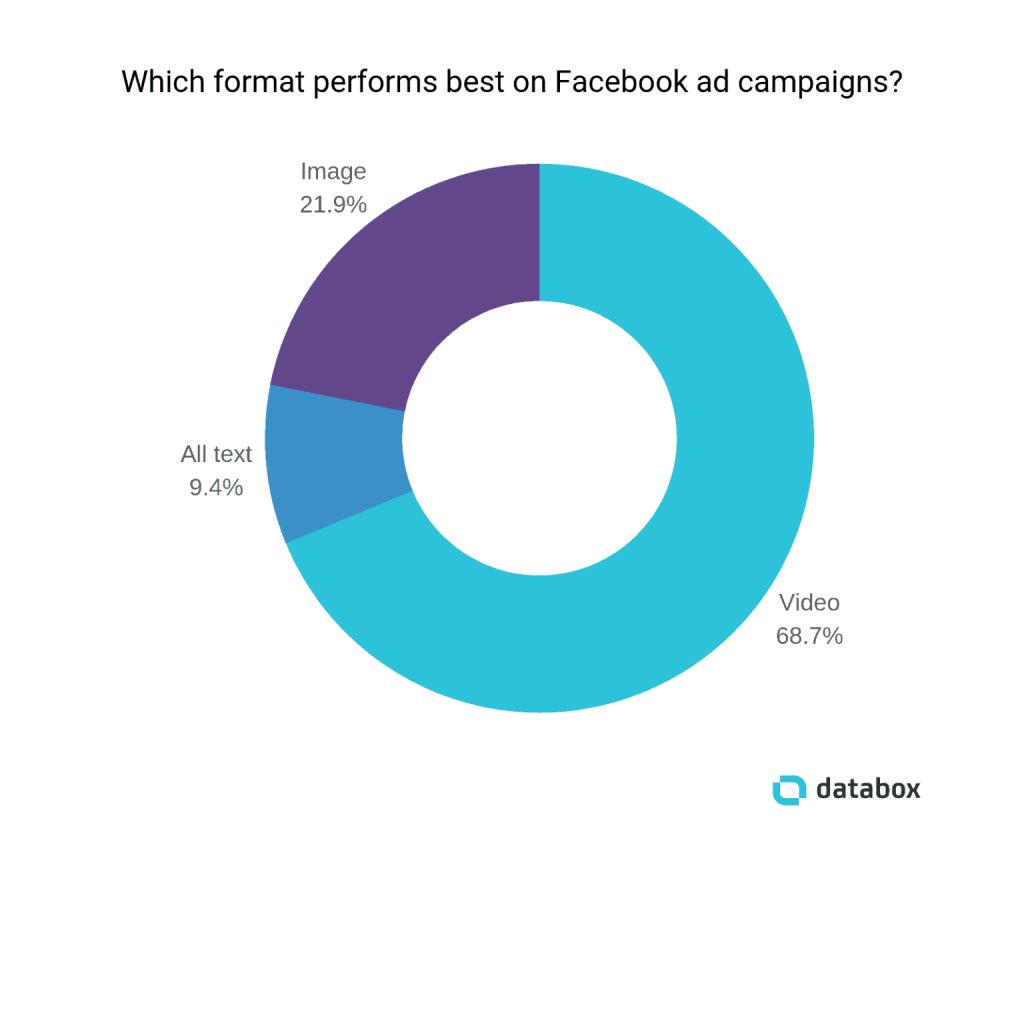
Run A/B Tests
Running A/B tests is an essential strategy for optimizing your Facebook campaigns and ensuring you’re maximizing your ad budget. This involves creating variations of your ad set, trying different images on your ad, headlines, or call-to-actions to discern which version resonates most with your target audience.
A/B is not just about making minor changes, it’s about understanding your audience’s preferences and behaviors. It’s a systematic approach that advertises Facebook’s users, allowing you to refine your targeting, enhance your creatives, and adjust your messaging.
You are not only targeting people, you are connecting with individuals, understanding their needs, and offering personalized and relevant solutions.
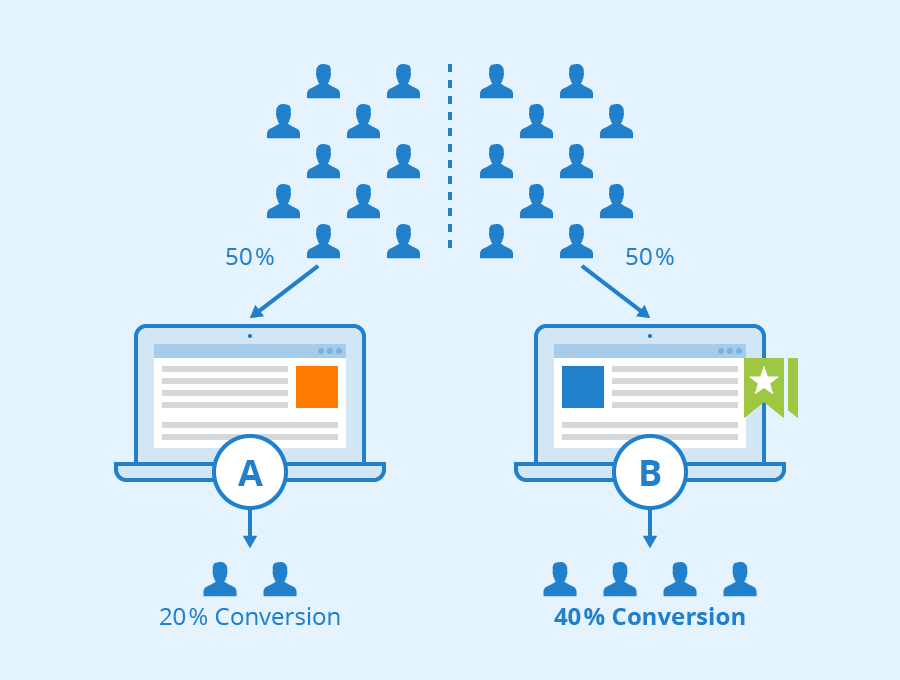
Here is a quick step-by-step guide to running an A/B test:
- Open Facebook Manager.
- Identify and select the campaign you wish to test.
- Click on ‘A/B Test’ in the toolbar.
- Select ‘Get started’ within the A/B test workflow.
- Decide a variable you want to test (e.g., Audience, Creative, Placements.)
- Assign a name to your test and establish the winning criteria.
- Edit the alternate version (change the copy, the image, or the video.)
- When your test is ready to go, Click ‘Publish.’
This strategy benefits businesses that want to drive more traffic to their site and make money with Facebook ads. The insights are invaluable, which help you identify what works and what doesn’t and make informed decisions on future creatives and strategies.
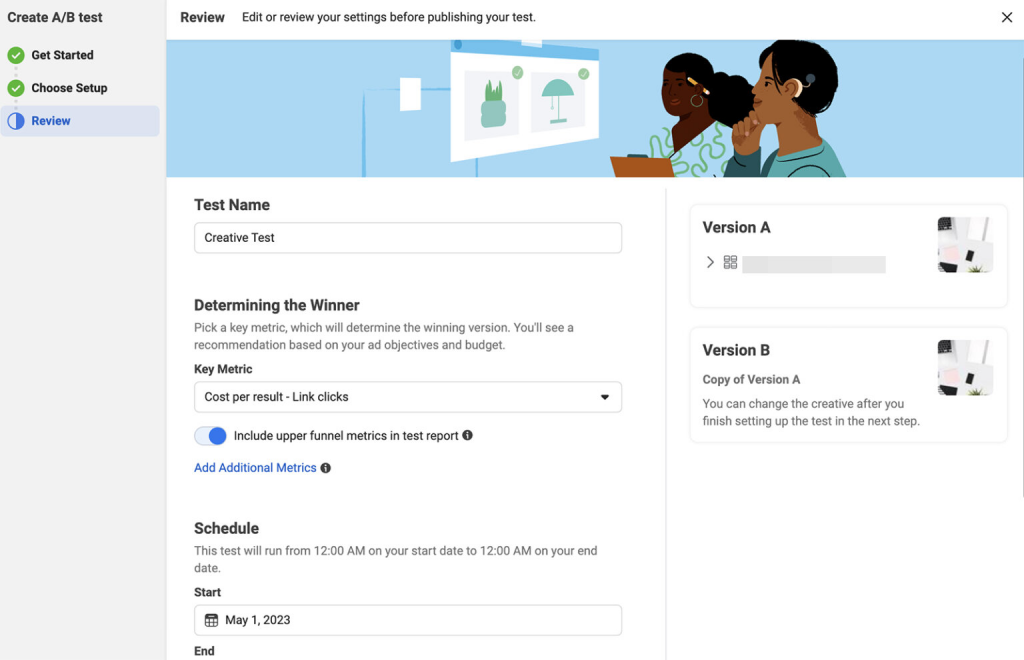
Enhance Your Landing Page
Optimizing your landing page is crucial for converting visitors into sales and preventing them from bouncing off your site upon arrival. You also must have a compatible and attractive design for mobile devices, given that a significant portion of Facebook traffic is generated through smartphones.
Follow the next recommendations to improve your landing page performance.
Focus On Speed
This is the essence of mobile destination pages. Slow-landing pages stress users, causing them to leave without engaging.
To enhance loading speed, consider reducing the page size, compressing images, and adopting progressive web applications. PWAs offer faster load times and more responsive user interactions.
Limit Images and Streamline Navigation
Even if images are visually appealing, they consume considerable space. We recommend limiting their use on mobile landing pages to maintain a clean layout.
Additionally, streamline the navigation menu to accommodate the constraints of mobile screens. Opt for a collapsed “hamburger” menu that guides users through different levels in a step-by-step manner.
Optimize Forms
Mobile screens are limited in space and need concise and clear content. Consider condensing large e-mail sign-up forms to fit comfortably on the screen without overwhelming the user and facilitating their buying process.
Likewise, shorten copy to transfer the message effectively without requiring excessive scrolling.
Craft Unique Mobile Landing Pages
Creating landing pages exclusively designed for mobile devices is an effective strategy for optimization. This approach eliminates the need to adjust elements of a standard web page to fit mobile screens.
You can direct users to the mobile-specific pages by crafting campaigns targeting only mobile traffic, ensuring a seamless experience.
3 More Tips to Make Money With Ad Campaigns
Creating a successful Facebook ad campaign requires creativity and strategy. You can create engaging ad sets and drive conversions by focusing on elements like the headline, social proof, and visual appeal.
Here are three quick tips specifically designed to help you make money through Facebook advertising:
- Redact a Catchy And Clear Headline: This is the first point of interaction between your ad and the viewers. It should be catchy enough to grab the audience’s attention and clear enough to convey the essence of your services or products.
For example, if you’re advertising a fitness service, a catchy and clear headline would be “Transform Your Body 30 Days.”
Remember to keep the headline relevant to the content. Misleading headlines may attract clicks but can lead to higher bounce rates and lower trust in your brand.
- Add Social Experiences in Your Ads: They testify to your services’ quality and effectiveness. Your ads can include customer testimonials, reviews, or user-generated content. This way, you will build trust and credibility.
This strategy encourages potential buyers to choose your services over others in the market.
Note: ensure that the social proof used is genuine and relatable. Fake or exaggerated claims can be easily spotted and may harm your brand’s reputation.
- Avoid Text-Heavy Graphics: Cluttering your ad graphics with excessive text overwhelms the message. Use clean, simple, and visually appealing graphics that complement the ad copy and effectively communicate your service’s proposition.
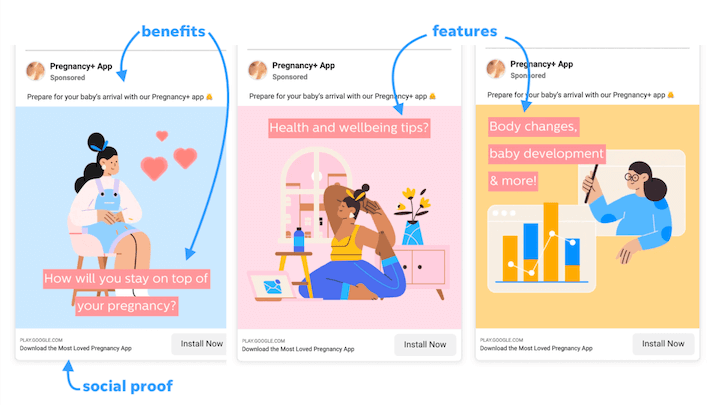
How to Make Money With Facebook Ads – Conclusion
Exploring Facebook advertising might be intimidating for many businesses, but it is a lucrative venture if you apply the correct strategies.
You can create a strong foundation for advertising success by knowing your campaign goals, targeting the correct audiences, and enhancing every element of your ad sets.
That’s why you should contact GamerSEO.
We take care of all the heavy lifting and set up your ad accounts and campaigns so you can sit tight and enjoy the benefits of a well-managed strategy.
With top marketing specialists within our staff, we ensure you’ll get results that improve how your business interacts with your target.
Don’t miss out and contact us now!

A PPC specialist who started with organic social media. For several years, the core of his activities are:- Google Ads, Microsoft Ads, Meta Ads, TikTok Ads, Twitter Ads, Linkedin Ads. He has led campaigns with a global reach, e.g. for FootballTeam, G2A, ETOTO, as well as many smaller campaigns in the sports, construction and financial industries. Has full focus on ROAS. Privately, a fan of football, history of wars and Star Wars.

